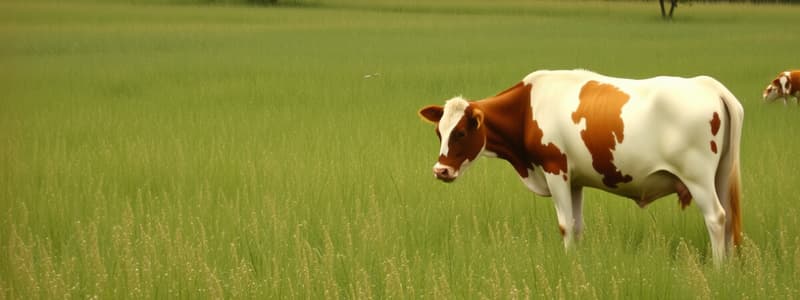Podcast
Questions and Answers
What is a key difference between cultivated forage and natural forages?
What is a key difference between cultivated forage and natural forages?
- Cultivated forages have lower yields than natural forages.
- Cultivated forages require less agronomic practice than natural forages.
- Cultivated forages are developed through breeding for improved characteristics. (correct)
- Cultivated forages are typically of lower quality than natural forages.
Which of the following represents a primary use of pasture grasses?
Which of the following represents a primary use of pasture grasses?
- Planting for erosion control
- Grazing systems for livestock (correct)
- Silage production
- Harvesting for seed production
What is the primary characteristic of fodder grasses compared to pasture grasses?
What is the primary characteristic of fodder grasses compared to pasture grasses?
- They are used primarily for grazing.
- They are typically taller and used in cut & carry systems. (correct)
- They are shorter in height.
- They have lower nutrient content.
What practice is NOT considered a proper agronomic practice for cultivated forage?
What practice is NOT considered a proper agronomic practice for cultivated forage?
What advantage does cultivated forage have over natural forages?
What advantage does cultivated forage have over natural forages?
Which characteristic is true for pasture legumes?
Which characteristic is true for pasture legumes?
What defines fodder legumes?
What defines fodder legumes?
Which statement is correct regarding the feeding of concentrates or compounded feed?
Which statement is correct regarding the feeding of concentrates or compounded feed?
Why is feeding green fodder important?
Why is feeding green fodder important?
What is the primary purpose of fodder crops?
What is the primary purpose of fodder crops?
Flashcards are hidden until you start studying
Study Notes
Cultivated Forage (Pasture)
- Also referred to as farm-grown pasture, cultivated for livestock feeding.
- Offers higher yields and improved quality compared to natural forages.
- Breeding programs focus on enhancing palatability, nutrient density, digestibility, and reducing anti-nutritive factors.
- Proper agronomic practices are essential for successful cultivation, including establishment, fertilization, harvesting, grazing, weeding, and irrigation.
Pasture vs. Fodder
- Pasture Grasses: Short grasses used in grazing systems (e.g., Brachiaria spp., Rye grass).
- Fodder Grasses: Tall grasses utilized in cut-and-carry (stall-fed or zero-grazing) systems (e.g., Napier spp., Guinea grass).
- Pasture Legumes: Short legumes used in grazing (e.g., Pueraria, Centrosema, Desmodium).
- Fodder Legumes: Tall legumes for cut-and-carry systems (e.g., Gliricidia, Ipil-Ipil, Erythrina).
Fodder Crops
- Cultivated plants specifically grown for livestock feed, primarily harvested for stall feeding.
Importance of Green Fodder Feeding
- Economical alternative to concentrates or compounded feeds, especially in regions where grains and oilcakes are costly.
- Green fodder can maintain cows producing 5-6 liters of milk daily without concentrates.
- Intensive livestock farming is not sustainable without year-round access to sufficient green or conserved fodder.
- Efficient forage production systems are necessary when land resources are limited.
Classification by Nutrient Density
- Non-Maintenance Forages: Examples include wheat straw and rice straw, often low in protein (5-12%).
- Maintenance Forages: Such as Sorghum, maize, and hybrid napier, provide base nutritional needs.
- High Protein Forages: Includes legumes like Berseem and Lucerne, containing 20-25% crude protein.
Forage Sources
- Cultivated Forage: Legumes (e.g., Alfalfa) and various cereal crops (e.g., sorghum, oats).
- Forest Edibles: Natural resources including shrubs and tree leaves.
- Grasslands (Pasture): Can be managed or unmanaged areas containing grasses and legumes.
- Aquatic Forage: Freshwater and marine algae, such as water hyacinth and Azolla.
Classification by Seed Type
- Forages are categorized into monocotyledons (grasses) and legumes.
- Legumes (family Leguminaceae) can be annuals (like Cowpea) or perennials (like Alfalfa).
- Non-legume fodders also exist in both annual (e.g., fodder maize) and perennial forms (e.g., Napier hybrid).
Forage Legumes
- High in crude protein (20-25%), improving overall fodder quality when combined with non-leguminous forages.
- Non-leguminous fodders provide necessary energy (carbohydrates).
- Typical feeding is 1-2% of livestock body weight.
Forage Grass Characteristics
- Belong to family Graminae (Poaceae); are herbaceous and monocotyledons.
- Features include fibrous root systems and unique leaf structures.
- Natural propagation occurs through seeds.
Forage Grass Propagation
- Stolons: Grow at or slightly below the soil surface; can form new plants from nodes.
- Rhizomes: Horizontal underground stems that give rise to new plants and store nutrients.
- Vegetative propagation is possible through stem cuttings, stolons, and rhizomes.
Multi-Purpose Trees (MPTs)
- Grown for multiple uses, including animal feed, human food, firewood, and mulch.
- Common species include both legumes (e.g., Gliricidia) and non-legumes (e.g., Jackfruit).
Grasslands
- Commonly referred to as pasture, these are areas covered with grasses and/or legumes, either naturally occurring or cultivated.
Studying That Suits You
Use AI to generate personalized quizzes and flashcards to suit your learning preferences.




